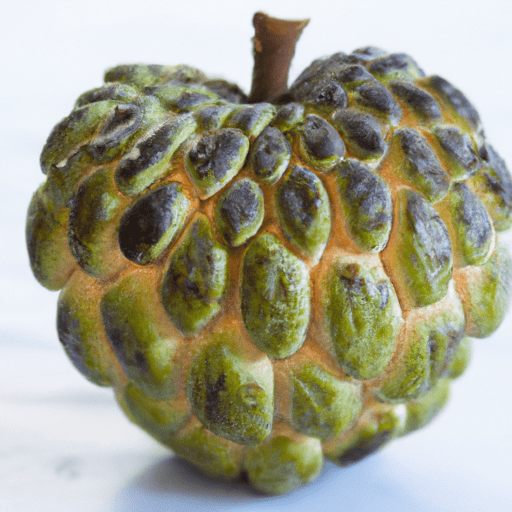Exploring the Delightful Sugar Apple: A Tropical Treat
If you’ve ever ventured into the lush tropics, you might have come across a unique fruit called the sugar apple. Known for its distinct appearance and exotic flavor, the sugar apple is a true gem among tropical fruits. In this blog post, we’ll dive into the world of sugar apples, offering you a tantalizing blend of culinary insight, nutritional value, and some intriguing historical facts. So, get ready to embark on a delicious journey!
Taste and Texture
The sugar apple is a small fruit that resembles an artichoke with its scaly green skin. However, its real magic lies inside. As you cut through the rugged exterior, you’ll discover a creamy, custard-like flesh that’s sweet and slightly tangy. This velvety texture melts in your mouth, leaving behind delicate notes of pear, pineapple, and vanilla. Its flavor is often described as a blend of tropical goodness, making it a coveted ingredient in various culinary creations.
Culinary Uses
Sugar apples are incredibly versatile and can be utilized in both sweet and savory dishes. The most common way to enjoy the fruit is to simply savor it fresh, relishing its natural flavors without any alteration. However, it can also be used in a plethora of delectable recipes.
Desserts
Thanks to its naturally sweet taste, sugar apples are a perfect choice for desserts. They can be transformed into heavenly mousses, silky custards, or refreshing sorbets. For a tropical twist, you can whip up a luscious sugar apple pie or blend it into a creamy smoothie coupled with coconut milk. Its unique flavor can elevate simple fruit salads, add a lovely touch to ice creams, or even be used as a filling for delicate pastries.
Savory Creations
Though sweet applications steal the spotlight, sugar apples can also shine in savory dishes. Their subtle tang and creamy texture make them an interesting addition to salads, salsas, and chutneys. Pair them with fresh herbs, citrus, or fresh seafood to create a delightful tropical-infused dish that will captivate your taste buds.
Nutritional Benefits
Delving into the nutritional aspect, sugar apples offer a plethora of health benefits. They are a great source of vitamin C, providing a natural boost to the immune system. Additionally, they contain dietary fiber, facilitating healthy digestion. These fruits are also rich in essential minerals like potassium, magnesium, and iron, contributing to overall proper bodily function. However, it’s important to note that sugar apples, like most fruits, should be enjoyed in moderation due to their naturally high sugar content.
A Brief History
Originating in South America, sugar apples have a long and fascinating history. They were cultivated by the ancient Aztecs and were considered a prized delicacy. Over the centuries, sugar apples made their way across the globe through trade routes, eventually finding a home in tropical regions such as Asia, the Caribbean, and parts of Africa. Today, they are cherished not only for their taste but also for their cultural significance in many cuisines worldwide.
Interesting Facts
To add a touch of intrigue to your sugar apple knowledge, here are a few captivating facts about this tropical fruit:
- Sugar apples are also known by other charming names such as sweetsop, custard apple, and graviola.
- The fruit is a part of the Annonacea family, which includes other tropical delights like cherimoya and soursop.
- In some cultures, sugar apples are believed to have medicinal properties, such as aiding digestive problems and providing relief from certain ailments.
So, whether you’re an adventurous foodie or simply someone with an appetite for new experiences, the sugar apple is a fruit that beckons you to explore its myriad culinary possibilities. Its tropical allure, delightful taste, and nutritional benefits make it a delectable addition to any kitchen. So why not try incorporating sugar apples into your next culinary creation? Your taste buds will thank you for it!
Sugar Apples
Origin: Sugar apples, also known as Annona squamosa, are native to the tropical regions of South America. They are believed to have originated in the West Indies or Central America but have been cultivated across various countries, including India, Thailand, and the Philippines.
Common Uses: Sugar apples are primarily consumed fresh, as they have a sweet and custard-like taste. The flesh is soft and creamy, and the flavor is often compared to a combination of pineapple and banana. They are commonly used in desserts, smoothies, ice creams, and milkshakes.
Nutritional Benefits: Sugar apples are a good source of several essential nutrients. They contain dietary fiber, vitamin C, vitamin B6, potassium, magnesium, and iron. Additionally, sugar apples are low in calories and fat, making them a healthier choice for satisfying sweet cravings.
Unique Properties: The fruit gets its name from the sweet flavor of its pulp, which is reminiscent of sugarcane. Sugar apples are oval-shaped and have a scaly green skin. Inside, the fruit is made up of numerous small, round segments filled with soft, juicy flesh and dark brown seeds.
Historical Significance: Sugar apples have a long history of cultivation and use dating back centuries. They were highly valued in ancient civilizations like the Aztecs and Mayans for their taste and medicinal properties. Today, they continue to be a popular fruit in tropical regions and are enjoyed for their unique and delicious flavor.




Use the share button below if you liked it.
It makes me smile, when I see it.